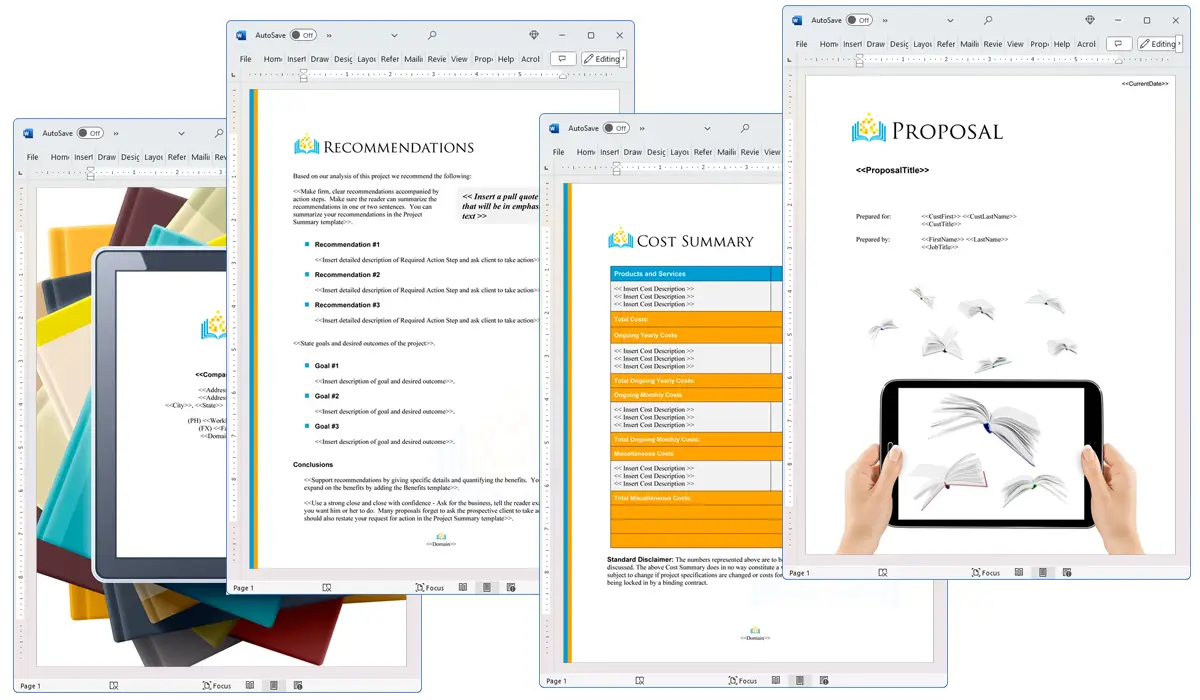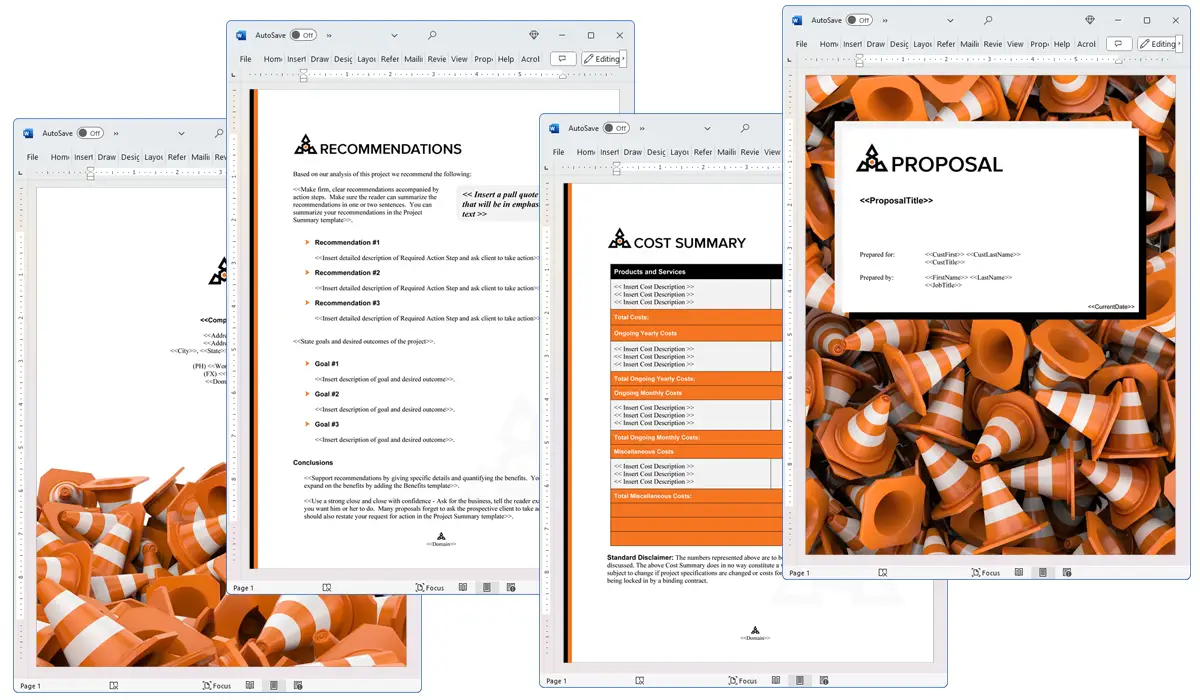What is the Sign Language chapter used for?
Proposal Kit Professional Bundle adds more design themes, all six Contract Packs,
a project management library, and Expert Edition software.

Illustration of Proposal Pack Books #4
We include this Sign Language chapter template in every Proposal Pack, along with thousands more. You assemble this chapter with others in various combinations to create custom-tailored business proposals, plans, reports, and other documents. Proposal Packs apply custom visual designs to the templates, giving the final documents a consistent professional finish.
 DOWNLOADABLE, ONE-TIME COST, NO SUBSCRIPTION FEES
DOWNLOADABLE, ONE-TIME COST, NO SUBSCRIPTION FEES
Overview of the Sign Language Chapter
The Sign Language chapter is a specialized part of the Proposal Kit system, designed to be used in proposals that involve sign language education, training, or interpretation services. This chapter template helps businesses and organizations clearly present information about sign language in their proposal documents, ensuring that the content is both informative and relevant to the proposal's objectives. Whether the aim is to provide sign language training, offer interpreter services, or even just educate about the benefits and importance of sign language, this chapter plays an important role in structuring the proposal to address specific needs.
How is the Sign Language Chapter Used?
Considering the situation of business proposals, the Sign Language chapter is used to convey detailed and specific information regarding sign language services that an organization intends to offer. This might include the scope of the services, the target audience, and the expected outcomes of providing such services. The inclusion of this chapter helps to enhance the proposal's credibility by demonstrating expertise and commitment to inclusivity in communication services. Moreover, it serves as a foundation to argue the necessity and benefits of integrating sign language into the recipient's operations or offerings.
What is Included in the Sign Language Chapter?
Typically, the Sign Language chapter includes several key elements:
- Introduction to Sign Language: A brief overview of what sign language is and its importance in facilitating communication for the deaf and hard of hearing communities.
- Services Offered: Detailed description of the sign language services being proposed, such as courses, training sessions, or interpretation services.
- Benefits: Explanation of the benefits that the proposed sign language services will bring to the organization and its stakeholders, emphasizing inclusivity and enhanced communication.
- Implementation Plan: An outline of how the sign language services will be implemented, including timelines, resources needed, and any partnerships or collaborations.
- Qualifications: Information about the qualifications and credentials of the personnel who will be delivering the sign language services, showcasing expertise and professionalism.
Use Case Examples for the Sign Language Chapter
- Employment: Proposals for workplaces aiming to enhance accessibility for deaf employees through sign language training programs.
- Human Resources: Inclusion in HR initiatives to promote diversity and inclusion policies within corporate environments.
- Social: Community centers or social groups proposing programs to bridge communication gaps between hearing and non-hearing community members.
- Community: Local government or non-profit proposals aiming to offer sign language interpretation services at public events.
- Faith: Religious organizations seeking to provide sign language interpretations of their services and activities.
- Training: Educational institutions proposing to include sign language courses in their curriculum.
- Education: Schools aiming to integrate sign language into their special education programs to support students with hearing impairments.
- General Information: Any organization looking to educate their audience about the importance and basics of sign language.
Key Takeaways
- Important Tool: The Sign Language chapter is an important tool in proposals related to sign language training, education, or interpretation services.
- Enhances Proposals: Including this chapter can significantly enhance the quality and focus of a proposal, making it more relevant and compelling.
- Promotes Inclusivity: It helps organizations demonstrate their commitment to inclusivity and accessibility.
- Versatile Applications: The chapter can be adapted for a wide range of industries and proposal types, from education to community services.
- Expert Presentation: Offers a structured way to present expert knowledge and detailed plans for integrating sign language into various environments.

Illustration of Proposal Pack Bullseye #4
 What Our Clients Say
What Our Clients SayWorth the extra cost to have both products to sell you product! Easy to use, great presentation! You will make your money back! I’ve been using this product since 2012 and always upgrade for the latest version! I recommend the Proposal Pack Wizard as well!"
One All Tennis Association
 4.7 stars, based on 849 reviews
4.7 stars, based on 849 reviewsRelated Chapters
Document Layouts Using the Sign Language Chapter

The Sign Language chapter and other chapters are integrated into a Word document as illustrated here in the Proposal Pack Safety #5 design theme. There are hundreds of design themes available, and every design theme includes the Sign Language chapter template.
A proper business proposal will include multiple chapters. This chapter is just one of many you can build into your proposal. We include the complete fill-in-the-blank template in our Proposal Pack template collections. We also include a library of sample proposals illustrating how companies in different industries, both large and small, have written proposals using our Proposal Packs. This template will show you how to write the Sign Language.
We include a chapter library for you to build from based on your needs. All proposals are different and have different needs and goals. Pick the chapters from our collection and organize them as needed for your proposal.
Using the Proposal Pack template library, you can create any business proposal, report, study, plan, or document.
The Wizard software includes an AI Writer, which will write the content of this and any other chapter of your document. Use the AI Writer to do the heavy lifting, writing the first draft of your proposal or business document in minutes.
 Ian Lauder has been helping businesses write their proposals and contracts for two decades. Ian is the owner and founder of Proposal Kit, one of the original sources of business proposal and contract software products started in 1997.
Ian Lauder has been helping businesses write their proposals and contracts for two decades. Ian is the owner and founder of Proposal Kit, one of the original sources of business proposal and contract software products started in 1997.By Ian Lauder
 Published by Proposal Kit, Inc.
Published by Proposal Kit, Inc.


 Cart
Cart
 Facebook
Facebook YouTube
YouTube Bluesky
Bluesky Search Site
Search Site